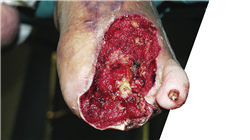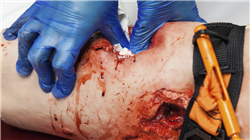University certificate
The world's largest faculty of nursing”
Introduction to the Program
With this 100% online Postgraduate diploma, you will identify the signs of Traumatic Wound complications and take preventive measures to avoid them”

The management of Traumatic Wounds has evolved considerably thanks to advances in medical technology and clinical research. An example of this is Negative Pressure Therapy, which promotes effective healing and reduces the risks of wound infection. In this context, nursing professionals play a vital role in the implementation of these innovations in daily clinical practice. For this reason, these experts need to have a thorough understanding of the most advanced treatments to address Traumatic Wounds and optimize clinical outcomes.
Given this scenario, TECH is launching a revolutionary Postgraduate diploma in Nursing Care of Traumatic Wounds. Designed by references in this field, the academic itinerary will address the preparation of the wound bed. In this way, professionals will make more accurate assessments of the state of wounds. In this regard, the syllabus will delve into the most sophisticated treatments for wound care, among which Negative Pressure Therapy, Hyperbaric Oxygen or Laser Therapy stand out. On the other hand, the didactic materials will delve into the management of severe burns, while at the same time offering the keys to combat the acute complications derived from these.
To consolidate all this content, TECH uses the avant-garde method of Relearning, which consists of the progressive reiteration of key concepts for their correct assimilation. In addition, the university program provides professionals with a variety of real case studies, allowing them to practice in simulated environments to bring them closer to the reality of emergency situations. In this sense, to access the educational resources nurses will only require an electronic device capable of connecting to the Internet. In addition, the program will feature the collaboration of a distinguished International Guest Director, who will offer thorough master classes to delve into the latest advances in the treatment of Traumatic Wounds.
An outstanding International Guest Director will give a rigorous Masterclass to delve into the most avant-garde treatments for the approach of Traumatic Wounds”
This Postgraduate diploma in Nursing Care of Traumatic Wounds contains the most complete and up-to-date scientific program on the market. The most important features include:
- The development of case studies presented by experts in Wound Care for Nursing
- The graphic, schematic and eminently practical contents with which it is conceived gather scientific and practical information on those disciplines that are indispensable for professional practice
- Practical exercises where self-assessment can be used to improve learning.
- Its special emphasis on innovative methodologies
- Theoretical lessons, questions to the expert, debate forums on controversial topics, and individual reflection assignments
- Content that is accessible from any fixed or portable device with an Internet connection
Do you want to incorporate into your daily practice the most sophisticated non-pharmacological strategies to alleviate the pain of Pediatric Skin Injuries? Achieve it with this program in only 6 months”
The program's teaching staff includes professionals from the sector who contribute their work experience to this program, in addition to renowned specialists from leading societies and prestigious universities.
The multimedia content, developed with the latest educational technology, will provide the professional with situated and contextual learning, i.e., a simulated environment that will provide immersive education programmed to learn in real situations.
This program is designed around Problem-Based Learning, whereby the professional must try to solve the different professional practice situations that arise during the course. For this purpose, students will be assisted by an innovative interactive video system created by renowned and experienced experts.
You will deepen in the Physiology of Traumatic Wounds, which will allow you to evaluate the factors that influence healing"

TECH's innovative Relearning methodology will allow you to update your knowledge in an autonomous and progressive way. At your own speed!"
Why study at TECH?
TECH is the world’s largest online university. With an impressive catalog of more than 14,000 university programs available in 11 languages, it is positioned as a leader in employability, with a 99% job placement rate. In addition, it relies on an enormous faculty of more than 6,000 professors of the highest international renown.

Study at the world's largest online university and guarantee your professional success. The future starts at TECH”
The world’s best online university according to FORBES
The prestigious Forbes magazine, specialized in business and finance, has highlighted TECH as “the world's best online university” This is what they have recently stated in an article in their digital edition in which they echo the success story of this institution, “thanks to the academic offer it provides, the selection of its teaching staff, and an innovative learning method aimed at educating the professionals of the future”
A revolutionary study method, a cutting-edge faculty and a practical focus: the key to TECH's success.
The most complete study plans on the university scene
TECH offers the most complete study plans on the university scene, with syllabuses that cover fundamental concepts and, at the same time, the main scientific advances in their specific scientific areas. In addition, these programs are continuously being updated to guarantee students the academic vanguard and the most in-demand professional skills. In this way, the university's qualifications provide its graduates with a significant advantage to propel their careers to success.
TECH offers the most comprehensive and intensive study plans on the current university scene.
A world-class teaching staff
TECH's teaching staff is made up of more than 6,000 professors with the highest international recognition. Professors, researchers and top executives of multinational companies, including Isaiah Covington, performance coach of the Boston Celtics; Magda Romanska, principal investigator at Harvard MetaLAB; Ignacio Wistumba, chairman of the department of translational molecular pathology at MD Anderson Cancer Center; and D.W. Pine, creative director of TIME magazine, among others.
Internationally renowned experts, specialized in different branches of Health, Technology, Communication and Business, form part of the TECH faculty.
A unique learning method
TECH is the first university to use Relearning in all its programs. It is the best online learning methodology, accredited with international teaching quality certifications, provided by prestigious educational agencies. In addition, this disruptive educational model is complemented with the “Case Method”, thereby setting up a unique online teaching strategy. Innovative teaching resources are also implemented, including detailed videos, infographics and interactive summaries.
TECH combines Relearning and the Case Method in all its university programs to guarantee excellent theoretical and practical learning, studying whenever and wherever you want.
The world's largest online university
TECH is the world’s largest online university. We are the largest educational institution, with the best and widest online educational catalog, one hundred percent online and covering the vast majority of areas of knowledge. We offer a large selection of our own degrees and accredited online undergraduate and postgraduate degrees. In total, more than 14,000 university degrees, in eleven different languages, make us the largest educational largest in the world.
TECH has the world's most extensive catalog of academic and official programs, available in more than 11 languages.
Google Premier Partner
The American technology giant has awarded TECH the Google Google Premier Partner badge. This award, which is only available to 3% of the world's companies, highlights the efficient, flexible and tailored experience that this university provides to students. The recognition as a Google Premier Partner not only accredits the maximum rigor, performance and investment in TECH's digital infrastructures, but also places this university as one of the world's leading technology companies.
Google has positioned TECH in the top 3% of the world's most important technology companies by awarding it its Google Premier Partner badge.
The official online university of the NBA
TECH is the official online university of the NBA. Thanks to our agreement with the biggest league in basketball, we offer our students exclusive university programs, as well as a wide variety of educational resources focused on the business of the league and other areas of the sports industry. Each program is made up of a uniquely designed syllabus and features exceptional guest hosts: professionals with a distinguished sports background who will offer their expertise on the most relevant topics.
TECH has been selected by the NBA, the world's top basketball league, as its official online university.
The top-rated university by its students
Students have positioned TECH as the world's top-rated university on the main review websites, with a highest rating of 4.9 out of 5, obtained from more than 1,000 reviews. These results consolidate TECH as the benchmark university institution at an international level, reflecting the excellence and positive impact of its educational model.” reflecting the excellence and positive impact of its educational model.”
TECH is the world’s top-rated university by its students.
Leaders in employability
TECH has managed to become the leading university in employability. 99% of its students obtain jobs in the academic field they have studied, within one year of completing any of the university's programs. A similar number achieve immediate career enhancement. All this thanks to a study methodology that bases its effectiveness on the acquisition of practical skills, which are absolutely necessary for professional development.
99% of TECH graduates find a job within a year of completing their studies.
Postgraduate Diploma in Nursing Care of Traumatic Wounds
Are you looking for a program that will give you the tools and knowledge you need to manage traumatic injuries? You are in the right place. At TECH Global University you will find a complete university diploma that will help you fulfill your academic goals. This course offers a comprehensive training that covers from the initial evaluation and treatment of wounds, to the most advanced techniques of care and prevention of complications. You will learn to apply best practices and evidence-based protocols to optimize patient recovery and improve clinical outcomes. In addition, you will address the importance of continuous patient assessment and adaptation of care plans to ensure optimal healing. Thus, you will acquire competencies in the identification of different types of wounds, the use of cutting-edge products or technologies and the implementation of pain management and infection control strategies.
Obtain a Postgraduate Diploma in Traumatic Wound Care Nursing
The online mode of this course allows you to access high quality specialization from anywhere in the world, offering invaluable flexibility. You will be able to progress at your own pace, adapting the learning to your personal and professional schedules and commitments. Course content is available 24 hours a day, seven days a week, facilitating dynamic and accessible study. The program is taught by experts in traumatic wound care, who bring with them their vast experience and knowledge. You will learn directly from recognized professionals in the field, which will enrich your understanding and application of advanced wound care techniques. Upon completion, you will be able to provide high quality care, contributing to a faster and more effective recovery of patients with traumatic wounds. Enroll now and prepare yourself to meet the related challenges, improving your clinical practice and bringing significant value to your patients and the healthcare community. We look forward to seeing you!







